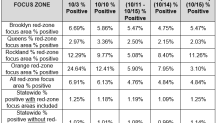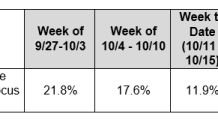What to Know
- NYC Mayor Bill de Blasio says it appears the Brooklyn and Queens clusters are leveling off, but he expects to have a fuller picture of any trends by Sunday; he says this is the 1st time the city has faced a true threat of "full-blown resurgence" since it emerged from lockdown
- The new restrictions have been imposed in red, orange and yellow zones in Brooklyn, Queens, Rockland, Orange and Broome counties for more than a week now; they're in place for a minimum of 14 days
- Most experts agree flare-ups will be the norm until there is a vaccine, and even afterwards, given the challenges with public trust, distribution and administration
A week into the latest COVID-19 restrictions in New York, Gov. Andrew Cuomo says it's still too early to tell whether the spread of the virus has slowed down enough to bring kids back to school and reopen businesses in hotspots.
It'll ultimately be his call whether to lift restrictions next week. They were put in place in geographically mapped cluster areas shaded red, orange and yellow based on risk for a minimum of 14 days, though that period could be extended.
In New York City, Mayor Bill de Blasio has touted hesitant signs of progress in Brooklyn and Queens red zones. He said there appears to be a plateauing -- the hotspot rates aren't increasing as consistently as they were and the city's daily case average appears to be leveling off after topping 500 for a number of days.
"There is a chance to get out of these restrictions as early as late next week, that's my goal and we are in striking range of that," de Blasio said Friday.
Week to date, state numbers show Brooklyn red zone positivity rates are 5.47 percent, down from 5.86 percent the week prior and 6.69 percent the week before that. The Queens red zones are at 2.5 percent this week, down from 3.36 last week and the week prior (2.97 percent). Rockland and Orange counties' red zone positivity rates have dipped as well amid the latest surge in enforcement efforts.
The red zones, which cover 2.8 percent of the state's population, are accounting for a smaller share of the state's new daily case totals as well, though the numbers are still disproportionate. As of Friday, they accounted for 11.9 percent of new daily cases this week, compared with 17.6 percent last week and 21.8 percent the week prior. They drove 11.7 percent of all cases statewide Thursday.
Still, even as numbers appear to be steadying, there is understandable frustration coming from residents left confused by the mixed messages regarding shutdowns from the mayor's and governor's offices. De Blasio was questioned on a radio show by a community board chair in Queens who was annoyed that the city's cluster map leaves blocks without any cases at all wondering why they're shut down, with clear data hard to find.
"Right now on his page, the recent metrics are only through the 10th of October...where are those cases coming from — cluster sites or not?" asked Alexa Weitzman. "Right now, it's Queens red zones and they are miles apart."
The mayor agreed with the complain, saying "it would be nice if (there was) one consistent approach from the beginning."
Adding to frustration, NYPD Commissioner Dermot Shea said that after so much focus was put on Brooklyn and Queens, there are new COVID concerns in a third borough: the Bronx, where there is a rash of new cases within the department.
New York City Councilman Mark Levine said Manhattan also needs to be on notice.
"Even in Manhattan, the rates are rising. September, 40 cases a day. Now 70, yesterday 98. People have to be cautious, even if they are not in hot zones," he said.


All of the developments beg the question: Is leveling off enough? The plateau this time around, if it is one, is infinitely lower than when New York hit its first plateau amid the crisis in late April. Nearly 20,000 people were hospitalized for COVID at that time. As of Friday, the state reported 918 total hospitalizations, up 21 from Thursday and down from 938 the Wednesday. Those numbers are still double what the state was seeing in early September. The clusters have driven about 70 percent of the admissions uptick.
The governor believes the same areas where he is seeing the hotspots involve the same people who never followed the rules in the first place in March, when the daily death and case tolls were rising exponentially each day and hospitals were setting up makeshift morgues in parking lots to handle the overflow of bodies. He threatened this week to pull state funding from localities that fail to enforce the laws and schools, some of which defied shutdown orders, that fail to obey them.
For Cuomo, managing the ongoing crisis is more a game of chess than it is checkers, he said in a conference call Thursday. The goal is to stay one step ahead. And the game keeps changing.
Small household gatherings are increasingly becoming the new COVID-19 battleground. CDC Director Dr. Robert Redfield and infectious disease expert Dr. Anthony Fauci both said this week that while large-scale compliance appears to exist overall -- as in, people tend to comply when they're in public -- they let down their guards in their own homes. That's especially a problem in multi-generational homes. New Jersey Gov. Phil Murphy, as he issued a warning on that Thursday, reminded the people of his state of the Fusco family, who lost five members.
Health officials across the country are increasingly concerned about the upcoming holiday season. Redfield and Fauci both warned that Thanksgiving could pose a major threat to the United States' war against coronavirus, given the recent increases in numbers. Cases have set new daily records again recently.
Many have said there may be no semblance of normalcy until an effective vaccine is available. But once it is, it will have to be widely distributed and administered, which poses additional complications. It could take until next spring to even have a vaccine ready to distribute to the masses, Fauci has said. He added that COVID precautions will still be needed after the initial rollout while state governments figure out how to get it to their people efficiently -- if they've even willing to take it.
As Cuomo said Thursday, "How am I supposed to get a vaccine to 20 million people? That's not what state governments do. Where do we go from here?"
Tracking Coronavirus in Tri-State
To that point, he, as chair of the National Governors Association, and the vice chair of NGA sent a letter to President Donald Trump Thursday asking for federal guidance on the states' roles in the vaccination distribution implementation program. Cuomo has already established an independent task force to review the safety of any vaccine the feds approve, but if his team OKs it, getting it out there to the mass population is a difficult task, as he says he learned while trying to distribute the measles vaccine during a 2019 outbreak in the state.
And that vaccine had already been around since the late 1960s. The general public and many scientists didn't even know COVID-19 was this time last year.
"You'll have a group of people who will say, 'We're not taking the vaccine.' How do you deal with that? It means you'll have ongoing small flare-ups of COVID," Cuomo said of the coronavirus vaccine challenge. "It gets very complicated very quickly and we need to know what is the plan, what does the federal government do, what do you expect the states to do? When does it start? Who funds it, et cetera? Let's figure it out now because this virus has been ahead of us every step of the way. It's about time this country catches up."
The U.S. eclipsed 8 million confirmed COVID cases on Thursday, which leads the world, and has reported nearly 217,000 deaths. Globally, there have been 38 million reported cases and 1.09 million confirmed deaths.



